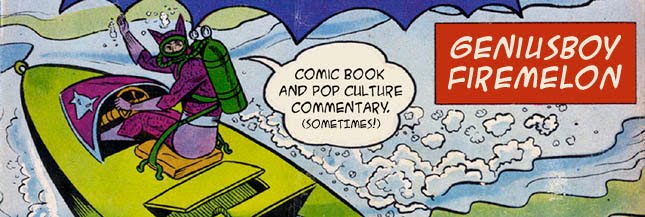 I'd love to do a longer post today, since I'm getting a bunch of hits lately (welcome, new readers!), but I'm up to my waist in the Legion book I'm editing, trying to get a version with images ready to send on to the next stage and (cross your fingers) publication in time for the New York Comic-Con.
I'd love to do a longer post today, since I'm getting a bunch of hits lately (welcome, new readers!), but I'm up to my waist in the Legion book I'm editing, trying to get a version with images ready to send on to the next stage and (cross your fingers) publication in time for the New York Comic-Con.So, since I don't have time to write anything substantial today, I'll give you something cool, at least. Here's bit of the Paul Levitz interview I conducted last year as research for my essay on Levitz's Legion run, presented here for the first time. (Thanks, Paul!)
Enjoy!
Tim Callahan: When you were doing your first Legion run, were you considering things like long and short-term pacing, or were you mostly working one issue at a time with sort of a vague perspective about the future?
Paul Levitz: I don’t remember enormously clearly...I certainly had a perspective of where I was going and some of the stories I wanted to do, and I usually had some idea a couple of issues out of where I was going on a subplot, but it was nowhere near as richly textured as the stuff I was doing when I came back. The JSA stuff I was doing at the same period as The Legion was probably much more carefully structured in terms of issue-to-issue character development.
TC: Just going back to the concept of threat level for a second, did you find it a problem dealing with threat level in The Legion? Because you’re dealing with so many intergalactic and global threats, it’s hard to provide much variety?
PL: No, because you’ve got a bunch of characters who, taken individually or even taken in a small group, don’t have the same kind of power. It’s one thing if you’re going to send Superboy, Ultra Boy, and Mon-El after something. It’s another thing if you’re going to send Dawnstar and Shrinking Violet. The other thing that I think it relevant in threat level is the threat level doesn’t so much come from the power of the villain as what is being threatened. And The Legion gave you excellent opportunities to do situations where individuals, personal lives, or families were what were being threatened.
TC: That makes sense. Now when you were plotting out your stories, did you try to give each Legionnaire a relatively equal amount of “screen time”? Did you say, “Cosmic Boy hasn’t appeared, so I’d better do somthing with him”? How did that work?
PL: I tried to--not so much to have everybody get equal time, but for everybody to have reasonable time. There were certainly occasions where I would go and say, “I haven’t done anything with this guy in a while, what can I do to screw up his life?”
TC: Right (laughs). And then you’d just create some sort of conflict.
PL: Uh-huh.
TC: When you approached a situation like that, would you start putting in hints, so it would sort of be the “c” or “d” storyline and have it slowly emerge?
PL: Sure. Once you make the decision, “I’m going to make Tim’s life miserable,” then you work back from that and say, “what am I going to do with Tim? Which of the plagues is he going to get? Ah, frogs! Okay. So we’re gonna start with an egg, then we’re gonna go tadpole, then we’re gonna have a frog, then we’re gonna have a whole [expletive deleted] lot of frogs.”
(laughs)
PL: It wouldn’t always mature as a plotline the way it started, because as you play with it you change it around, but you do your best to evolve it that way.

6 comments:
Huh, that question about members and threats made me wonder...
Why would superhero teams have members who just shrank or did other "lame" stuff? I mean, logically--WHY? (And please do avoid an answer that requires a writer to give the villain some stupid-as-fuck weakness that only a lame-as-hell power can take advantage of, because that's not a real answer.)
There are no lame superheroes, especially 1,000 years in the freakin' future! Just try to wrap you brain around that. Heroes, in the future!
Plus, the Legion is famous for rejecting people with lame powers. There's entire storylines about it.
The Legion of Substitute Heroes prove that there are no lame characters.
Right. But he's got PERSONALITY. That's what he brings to the party.
Except in the cartoon version, where he brings wicked sweet goggles.
Chad - because it's not all about the hitting. Shrinking Violet fills the "Atom" role on the team (although I think she actually predates him as a character) for espionage, hiding, spying. She was a charter member of the Legion Espionage Squad.
See, I know those reasons and I wonder if that's the real truth (and I'm speaking here about superhero teams on a larger scale, not just the Legion). Do these heroes with seemingly "lame" powers actually do much or does it just seem like they do? It makes me want to go back and look at old stories and see which characters are actually responsible for defeating villains. For example, in Jim Starlin's three "Infinity" books in the '90s, every Marvel hero basically appeared, but if you read the books closely, you'll realise only Adam Warlock and Thanos resolve the situations--the other heroes do nothing of consequence. Have superhero comics been operating this way for years, covering for the likes of Ant-Man, the Wasp and that fat bouncing guy?
Post a Comment